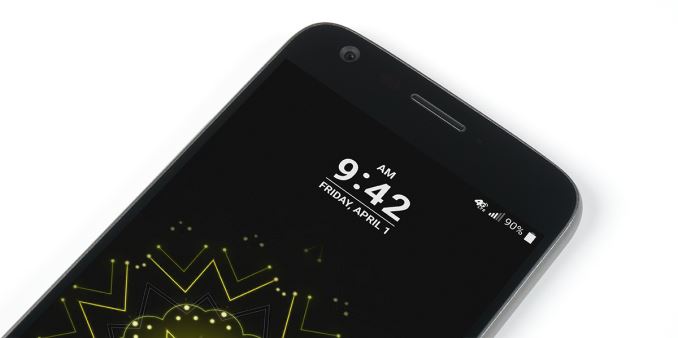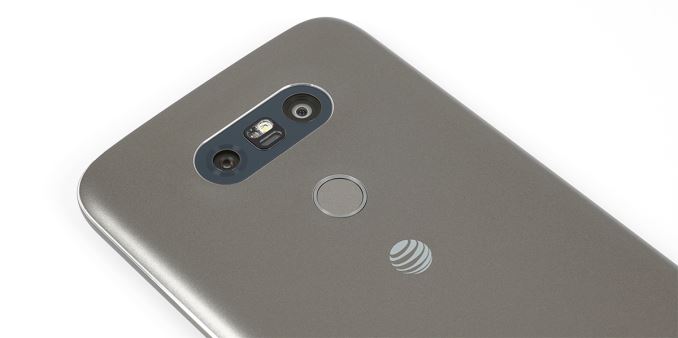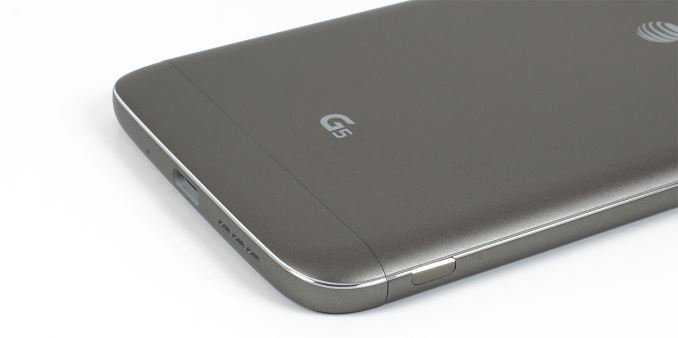The LG G5 Review
by Matt Humrick on May 26, 2016 8:00 AM EST- Posted in
- Smartphones
- Snapdragon
- Qualcomm
- LG
- Mobile
- Snapdragon 820
- LG G5
Final Words
With so many smartphones to choose from, it’s difficult for any one device to stand out. This is especially true for flagships that come packed with the best hardware and nearly every feature available. The implementation of these features and how they contribute to a positive user experience—a bright screen with accurate colors, a fingerprint reader that’s fast and accurate, a high resolution camera that actually takes good pictures, software enhancements that improve usability and customizability without adding bloat—was a differentiator in the past, but I would argue that with the smartphone market maturing and the price modern flagships sell for, there’s little room for compromise here either.
The G5 comes with an impressive list of hardware, but combining a removable battery with an aluminum unibody design is the G5’s big innovation and highlight feature. LG’s mechanism works well, with two minor exceptions: The chin section requires some work before it pulls free and the plastic battery retention scheme raises some concern about durability.
The modularity this design affords is a bonus, but we’re not sure this idea will catch on. Currently there’s only two modules available: the LG CAM Plus, which is a hand grip that adds physical buttons for some camera controls and comes with its own larger battery, and the LG Hi-Fi Plus with B&O PLAY, which adds a Hi-Fi DAC for audio playback (not available in the U.S.). There is an HDK and SDK, which opens the door for third-party modules in the future, but the G5 will need to sell in sufficient quantities to make it worthwhile for companies to develop them. Also, the design of any future LG phones will need to be dimensionally compatible with the G5 or the current modules will no longer work. Maintaining this design constraint for more than a couple generations seems impractical.
The G5’s design and materials are a big departure from previous G Series phones. While the appeal of its new appearance is open for debate, we can definitively say that its ergonomics are excellent. The rounded corners and curved back edges eliminate pain points when holding the phone, and the polished step where the back meets the sides provides enough purchase to keep the phone from feeling slippery. The front is covered by LG’s 3D Arc Glass, which adds a large radius along the top edge where the speaker is located. This too serves an ergonomic purpose: It helps the phone lay more naturally against your ear and eliminates another sharp edge.
With a Snapdragon 820 SoC, 4GB of LPDDR4 RAM, and UFS 2.0 storage, the G5 uses much of the same internal hardware as other flagship phones of its generation. It’s no surprise then that it delivers excellent performance. While the Kirin 950 and 955 SoCs in Huawei’s Mate 8 and P9, respectively, perform better than the G5’s Snapdragon 820 in our system tests, and the G5 is a tick slower than its peers in our web tests, its Adreno 530 GPU is a top performer and the phone feels plenty fast in general.
There are several implementation issues that negatively impact the G5’s user experience, however, starting with the display’s lack of calibration. It’s exceedingly cold white point gives the screen a noticeable blue tint and grayscale and sRGB color accuracy are poor. The G5’s LCD display is capable of reaching an impressive 800 nits brightness using LG’s Daylight Mode feature with auto-brightness enabled, but this is only temporary. Over a period of two minutes, the display gradually dims until it hits a stable value of 405 nits. Peak brightness is even worse in manual mode: After reaching a peak value of 405 nits, the backlight drops to a stable value of only 334 nits after 45 seconds. LG is a leading supplier of LCDs for mobile devices, and its flagship phones should serve as a showcase for its technology. Sadly, this is not the case for the G5.
Besides the removable battery, the G5’s other semi-unique feature is its dual rear camera. While there are certainly uses for the second wide-angle camera, we feel that the image distortion that results from using a fisheye lens will severely limit how often it’s used. Using the two cameras together could potentially boost image quality for every picture taken and would be a better use of resources, rather than letting one of the cameras always sit idle.
The G5’s rear cameras do take excellent photos in bright light, equaling the Galaxy S7’s image quality, but fall short of expectations in lower-light conditions. The G5 still does well handling white balance and exposure; however, its images show a significant amount of noise that noticeably degrades quality. LG also has not significantly updated the G Series’ video recording capabilities in two years, which puts the G5 on par with current mid-range phones today.
Just below the dual rear camera module is another new feature for the G5: a combination fingerprint reader and power button. While it’s located in a convenient spot, its accuracy is very poor. I have not had this much trouble with a fingerprint sensor since the Galaxy S5. Even when the sensor works it takes multiple attempts. Having to punch in my pin code after five failed attempts was a regular occurrence. I had a similar experience with two different G5’s, so this issue is not because of a single faulty unit.
Ultimately, the G5, like the G4, ends up feeling like an upper mid-range phone rather than a true flagship. It does have a nice array of features, including a removable battery—a true rarity these days—and microSD support, along with excellent performance, but many of its features are poorly executed. If the G5’s price falls to $500 USD or less like it did with the G4, it would be easy to recommend, especially if you need the removable battery. At its launch price, however, it seems overpriced relative to the competition.














92 Comments
View All Comments
LiverpoolFC5903 - Tuesday, June 21, 2016 - link
Not everyone buys phones as soon as they are launched. A couple of months is not 'old' by any stretch.You get the most detailed technical and scientific review out of any website, which is a trade off I am happy to make. Better late than crap is my motto. Amen.
Oyeve - Saturday, May 28, 2016 - link
True. Still waiting for an S7 review and an LGV10 review. Anandtech really lacks the quality it once had.RazrLeaf - Thursday, May 26, 2016 - link
Whee! (I'll edit this part after I finish reading)Aside: Is S7 part 2 done yet?
DanNeely - Thursday, May 26, 2016 - link
Yup. It was actually finished months ago. They're just sitting on it to spite you and to fuel bias conspiracy theories by other commentators. /stheduckofdeath - Thursday, May 26, 2016 - link
The Galaxy S7 is the blockbuster release of this year. It's getting ridiculous that Anandtech can't prioritise reviews in their pipeline. And seriously, amongst the big brands, there has been half a dozen phones really relevant to review since the Mobile World Congress this winter, and still the full S7 review isn't out.Sure, it hurts Anandtech more than it hurts readers, as people will just stop coming here when they notice magazines, delivered by snail mail, produces reviews months before the once great Anandtech.
ianmills - Friday, May 27, 2016 - link
Jokes on you brother as we still can't edit comments on this site loljjj - Thursday, May 26, 2016 - link
PCMark is kinda weird. Look at Meizu M1 Metal with Helio X10 (A53@2GHz) http://www.futuremark.com/hardware/mobile/Meizu+m1...Web Browsing score 5655
Video Playback score 2713
Writing score 7313
Photo Editing score 6013
Video score is low, photo editing is in part on GPU so you would expect a lower score but 6k is rather great given the small GPU.
And then you got web browsing and work , the most relevant scores, at flagship perf somehow.
I know what it does and how but not sure how relevant it is and if something is off here.
No storage perf in this review? Would have been interesting to see how storage speeds correlate with DiscoMark results.
You guys really need to get some SD652/650 and Helio X20 results in the charts, it feels outdated without.
xdamm - Thursday, May 26, 2016 - link
Wow, I immediately noticed the screen was quite shite based on hands-on videos from their event a few months back, but I didn't think production units would have such a crap display as well.Shame on you, LG.
K_Space - Thursday, May 26, 2016 - link
Is this a panel issue or can this be sorted out with an firmware update?Matt Humrick - Thursday, May 26, 2016 - link
The light bleed is a panel issue, but the other problems could be improved with a software update; however, the G4 suffers from many of the same issues and it has yet to receive an update to correct them.We've also noticed that firmwares for different regions/carriers are not equivalent; they may use a different white point or disable the auto-dimming behavior in manual brightness mode, for example.